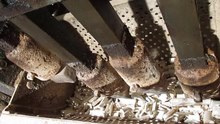Bone mill (Fretter)
The bone mill is a listed building in Fretter , a district of Finnentrop in the Olpe district ( North Rhine-Westphalia ). The inventory is also under monument protection.
History and architecture
The mill with water wheel and a small half-timbered building was built around 1900 and belongs to the Ruhrmann farm in Fretter. The cast iron stamping mechanism was made before 1900. This is one of two sets of an ore and slag poche that was previously in service in a steelworks and was manufactured around 1860. This hut was probably the Finnentroper hut , which was operated from 1858 to 1901. The drive of the ramming mechanism was taken over by the overshot waterwheel via a drive shaft with gear transmission. This drive also made it possible to drive a grindstone.
The mill crushed around 1500 to 2000 kg of bones each winter, farmers in the area used the material obtained as organic fertilizer. Beef and pork bones were supplied by the butchers and junk dealers in the area; the bones had to be stored in the attic for two years before processing. The plant was shut down in 1945. The facility, protected as a technical cultural monument , was restored between 1987 and 1989 and has been operational since 2014. The mill is - especially because of the poche - unique in North Rhine-Westphalia.
Web links
- Pages of the Olpe district museum landscape
- Bone mill in Fretter lenneroute.de
Individual evidence
- ↑ Designation as a cultural monument
- ↑ a b bones mill in Fretter lenneroute.de
- ↑ Current usage
Coordinates: 51 ° 11 ′ 41.6 ″ N , 8 ° 3 ′ 24.5 ″ E

